Dow Theory: Definition, Origin, Principles, and Example
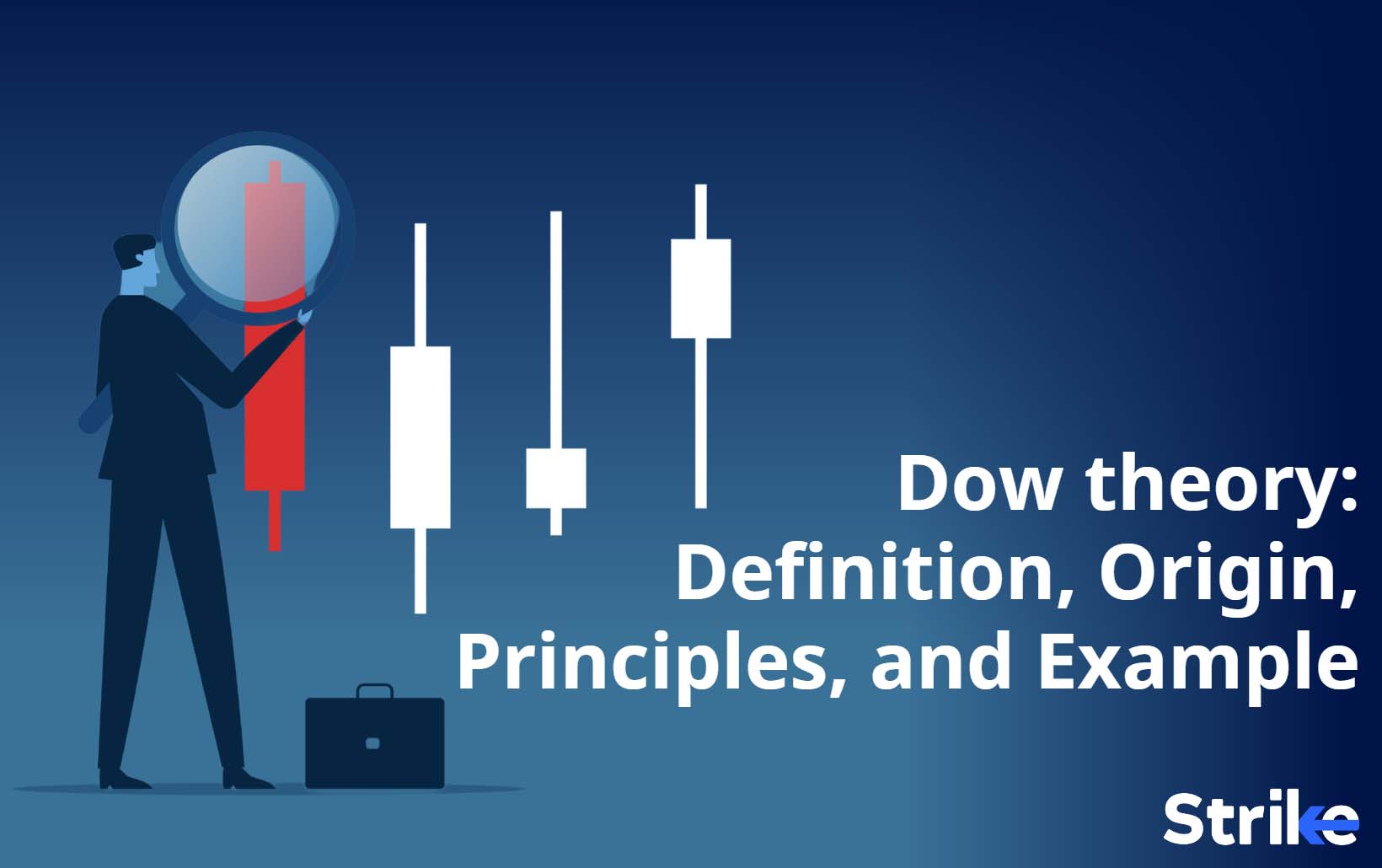
Dow theory is a technical analysis approach that suggests markets move in three self-repeating phases called the Accumulation phase, the Markup phase, and the Distribution phase. Dow theory proposes that the market is in a bullish trend if one of its indices, such as industrials or transportation, advances above a previous important high and is accompanied by the other average.
Dow theory originated in the early 1900s through a series of articles about it by Charles Dow. Dow theory is named after Charles Dow, the founder of the Wall Street Journal, and his partner Edward Jones. Dow theory is also known as Dow Jones theory.
Dow theory has six main principles. The principles are the averages undervalue everything, the market has three trends, primary trends go through three stages, the averages must verify one another, volume supports the trend, and a trend continues until it issues a clear reversal signal.
In the video guide below on Dow theory, we will learn in detail.
What is the meaning of Dow theory?
Dow theory is a technical analysis approach to stock market forecasting based on the idea that market trends exist despite any noise in the market. Dow theory is predicated on the notion that the market discounts everything, which is consistent with the efficient market hypothesis. The market has three trends according to the Dow theory, which are primary, secondary, and minor, and these trends go through three stages: accumulation, public participation, and distribution. The theory also proposes that market averages must verify one another and that volume supports the trend. A trend is assumed to continue until there is evidence of a reversal, and the theory is widely used in technical analysis to identify market trends and potential changes in direction.
The Dow theory was developed by Charles H. Dow, the founder of the Wall Street Journal. Dow’s principles were published through a series of 255 articles in the Wall Street Journal between 1900 and 1902.
Dow theory is represented by a line chart with each of the three trends plotted on the chart. The primary trend is represented by a line chart with diagonal lines going up or down; secondary trends are represented by shorter-term lines that move in the opposite direction to the primary trend; and minor trends are represented by even shorter-term lines that are usually perpendicular to the primary trend. The graphical representation of the dow theory is shown below.
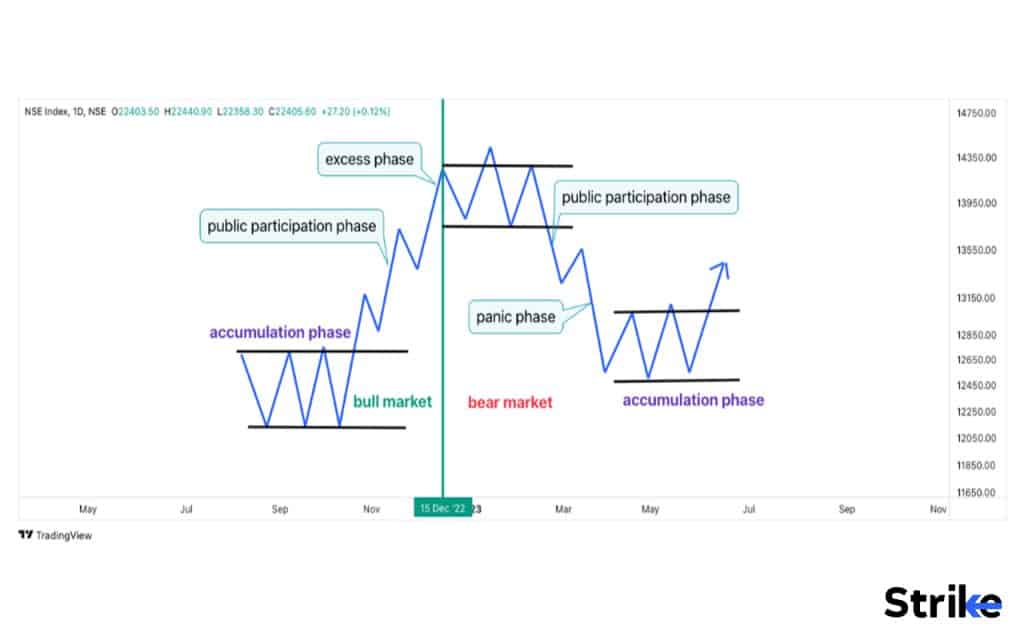
Dow theory’s primary use is to help traders identify market trends. This can be used to make profitable trades. Traders who use Dow theory to analyse the market look at the behaviour of market averages.
For example, a trader using Dow theory might have created a strategy with a robust risk management system and an edge created by gathering different indicators and tools. A trader may apply this theory widely across all the securities. Suppose, a trader observed an accumulation phase in the Nifty 50 index. After the breakout of the upper resistance, a dow theory trader may use technical tools like fibonacci to mark the move that caused the breakout and try to identify discounts. This way, A HH (higher high) followed by a HH suggests a dow theory trader, that the market will continue in the upward direction and he/she is supposed to identify sufficient discount levels which may arrive around a strong HL (higher low) to find appropriate entries.
What is the other term for Dow theory?
The other term for Dow theory is “Dow Jones Industrial Average theory“. The name represents its publishers Charles H. Dow and Edward Jones.Charles H Dow was an American journalist and Edward Jones was a statistician. Both are closely associated with the stock market.
What is the Origin of Dow theory?
The Dow theory was published through a series of articles by Charles H. Dow in the Wall Street Journal between 1900 and 1902.
Dow was a journalist and financial analyst who was the founder of the Wall Street Journal. The articles outlined his theory of market behaviour and technical analysis. Dow died in 1902, and it was left to his successor, William P. Hamilton, to further develop and refine the theory.
Hamilton published “The Stock Market Barometer,” a book that expanded on Dow’s theories in 1922 and established the Dow theory as a fundamental part of technical analysis.
In 1932, Robert Rhea published “The Dow Theory,” which further developed and refined Dow’s original ideas. E. George Schaefer “How I Helped More Than 10,000 Investors to Profit in Stocks” in 1960 included a section on Dow theory. Richard Russell‘s “The Dow theory Today,” published in 1961, provides a modern interpretation of Dow’s ideas and is still widely read today.
How does Dow theory work?
The Dow theory works by attempting time entries and exits (buying and selling of stocks) using stock market characteristics such as price trends, volume etc. Dow’s theory is based on five concepts. The first concept states that the market moves in three ways.
The first principle is the primary trend. The primary trend lasts from a few months to even a year. Dow theory is best utilised when investors catch on to this trend and invest.
The next trend is called secondary. The secondary trend runs counter to the primary trend. It lasts more than 10 days. The stock loses up to 66% of its value by this point.
The third is a short swing. The short swing usually lasts only a few hours. Dow theory describes this phase as noise, considering it has the least value.
The primary trend has three phases. These are called the Accumulation phase, the Markup phase, and the Distribution phase. Take a look at the graph.
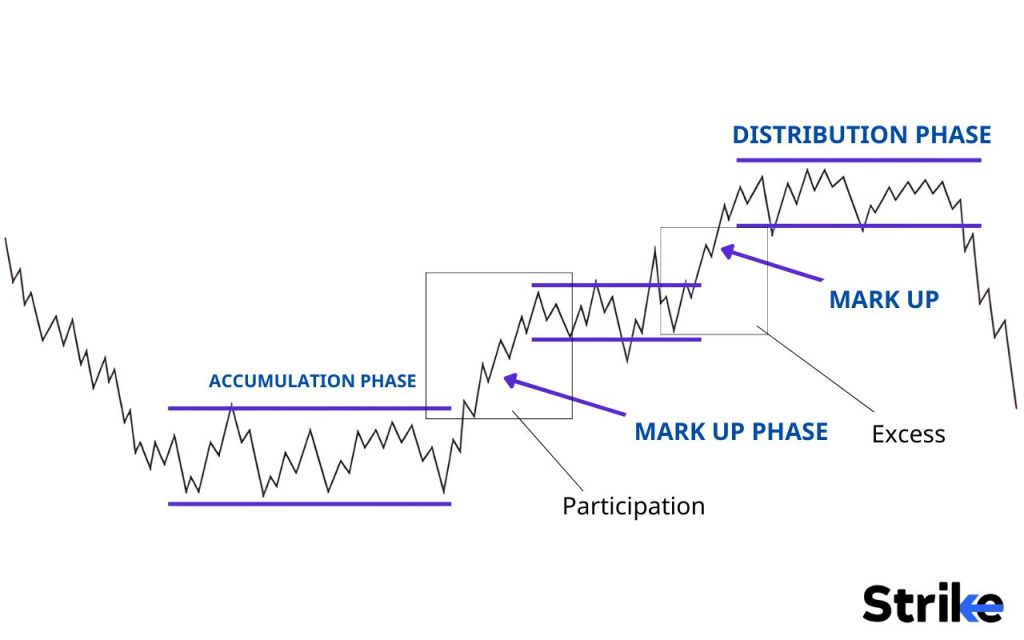
The three phases continue to happen as per Dow theory and within each pattern, too, there are minor similar patterns. This knowledge helps traders and investors use Dow theory in technical analysis and trade or to invest accordingly.
The second idea of the Dow theory is that stock markets react immediately to news and new information. This means that new information can immediately change the overall movement of the market.
The third theory explains the relationship between Dow Jones Industrial Average (DJIA) and Dow Jones Transportation Average (DJT) index. These indices represent manufacturing and transportation industries. Charles Dow believed these two industries were the most important to the stock market. Both DJIA and DJT tend to move in the same direction. Dow theory states that these indices moving apart is a sign of market reversal. An example of this is given in the below chart.
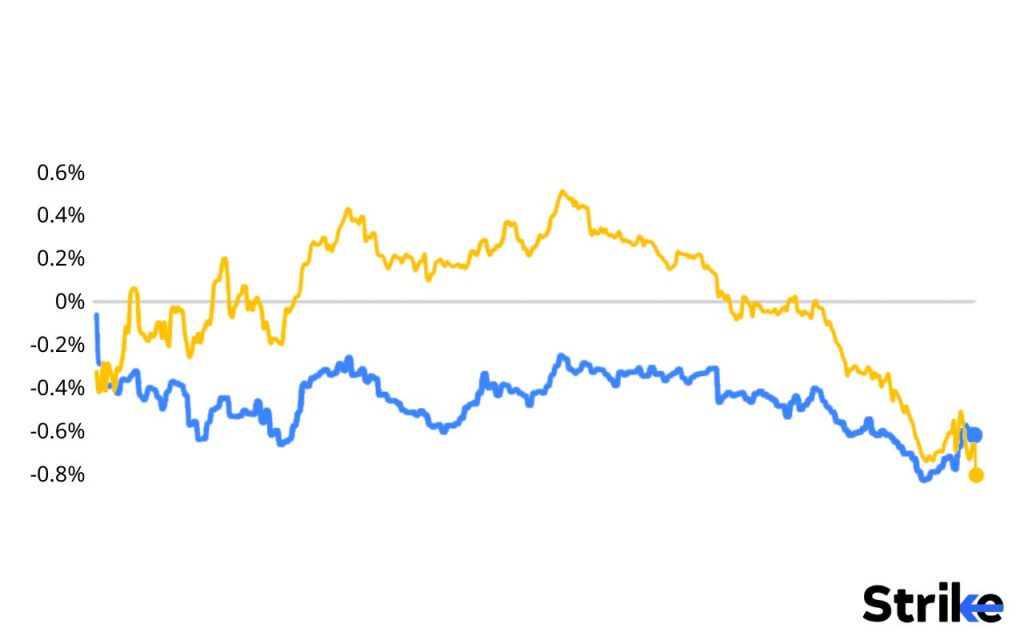
Now, look at the below graph.
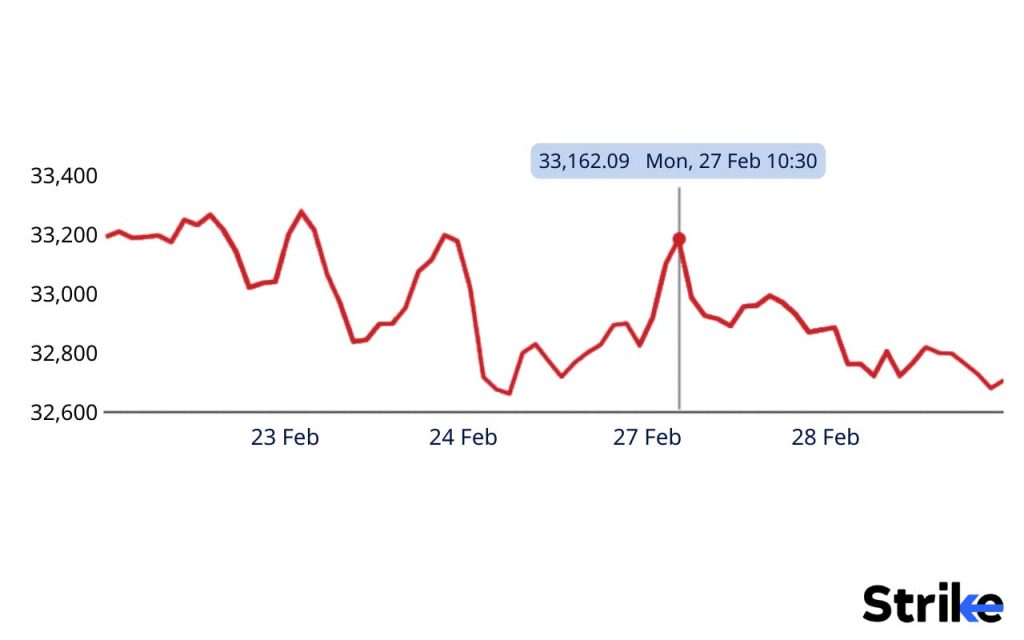
The Dow Jones index shows a trend reversal during the same time period. Dow Jones Industrial Average represents the overall sentiment of the U.S. stock markets.
The fourth concept of Dow theory is that volume must confirm the trend. The theory suggests that a relatively high volume is necessary to confirm a trend.
The fifth idea of Dow theory explains that trends will continue until there are definitive signals that prove otherwise.
Combining the five ideas of the Dow theory is an ideal way for an investor or trader to predict the stock markets. The information helps traders organise their exit and entries.
What factors affect Dow theory?
Market sentiment is an important factor in Dow theory as it reflects investor sentiment and how they perceive the stock market. Positive sentiment is associated with a rise in the stock market prices, while negative sentiment is associated with a decline.
Volume is an important factor when it comes to Dow theory as it reflects the number of trades that occur in the stock market over a given period. Higher volumes indicate strong market participation and greater liquidity. This is a sign of a healthy market and is seen as a positive indicator by Dow theory proponents. But investors and traders are supposed to take into consideration that the volume indicator may become unviable as it does not show the real disclosed quantity of shares traded by big players.
What are the basic principles of Dow theory?
Dow theory consists of six basic principles. The six principles of Dow theory states that averages undervalue everything, the market has three trends, primary trends go through three stages, the averages must verify one another, volume supports the trend, and a trend continues until it issues a clear reversal signal. Below is an explanation of the six principles.
1. The Averages Undervalue Everything
The notion that averages undervalue everything is one of the major principles of the Dow theory. This indicates that stock market averages, such as the Dow Jones Industrial Average and the Nifty 50, do not reflect the true value of individual stocks or the market as a whole.
This is due to the fact that stock market averages are weighted indices, which means that the largest companies in the index have a greater impact on the index’s performance than smaller companies. The index as a whole may be rising, even if many smaller companies are struggling when the larger companies in the index are performing well.
2. Three trends make up the market.
Dow theory suggests that the market is made up of three trends.
The three trends are primary, secondary and tertiary.
The primary trend is the most significant and can last for months or even years, indicating the overall direction of the market. It can be bullish or bearish.
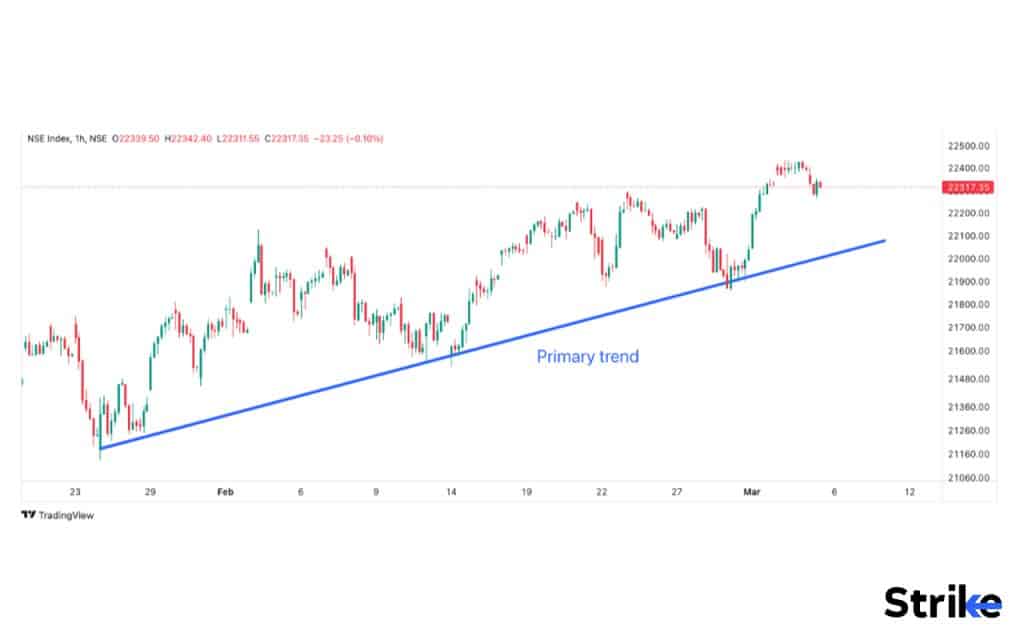
The secondary trend is the correction that occurs within the primary trend, lasting for weeks to a few months. This is a minor counter-reaction to the larger movement in the market and is often when the public starts to invest.
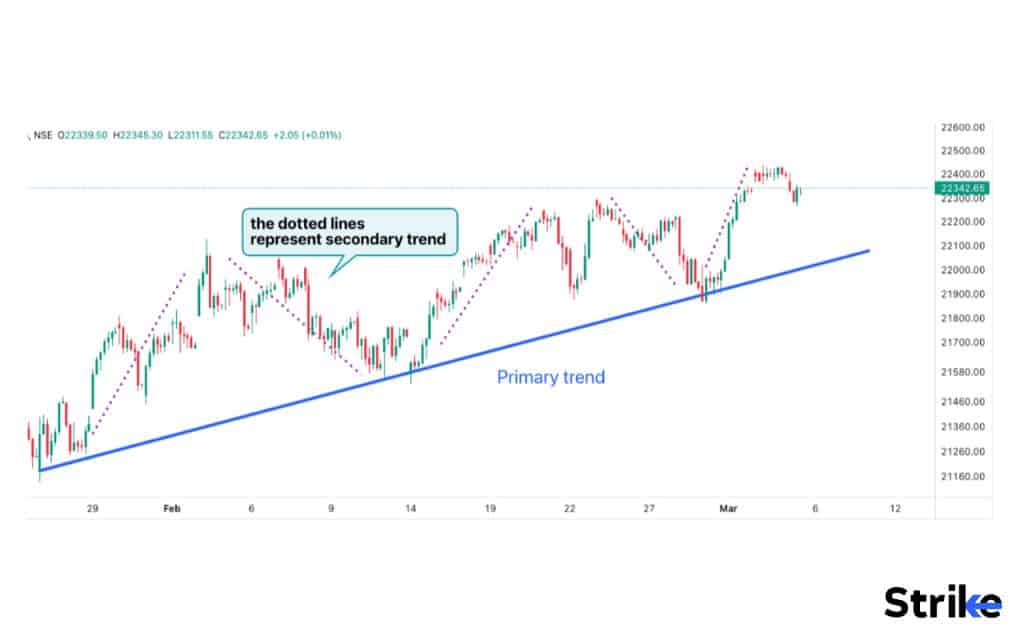
Lastly, the tertiary trend is the shortest-lived trend, lasting for only a few hours, a day, or up to ten days. It is typically insignificant and does not impact the market significantly. Which can be observed in the above picture; minor ups and downs.
3. Primary trends go through three stages
The Dow theory says that the primary trend has three phases. The three phases are accumulation, markup, and distribution. Take a look at the below graph.
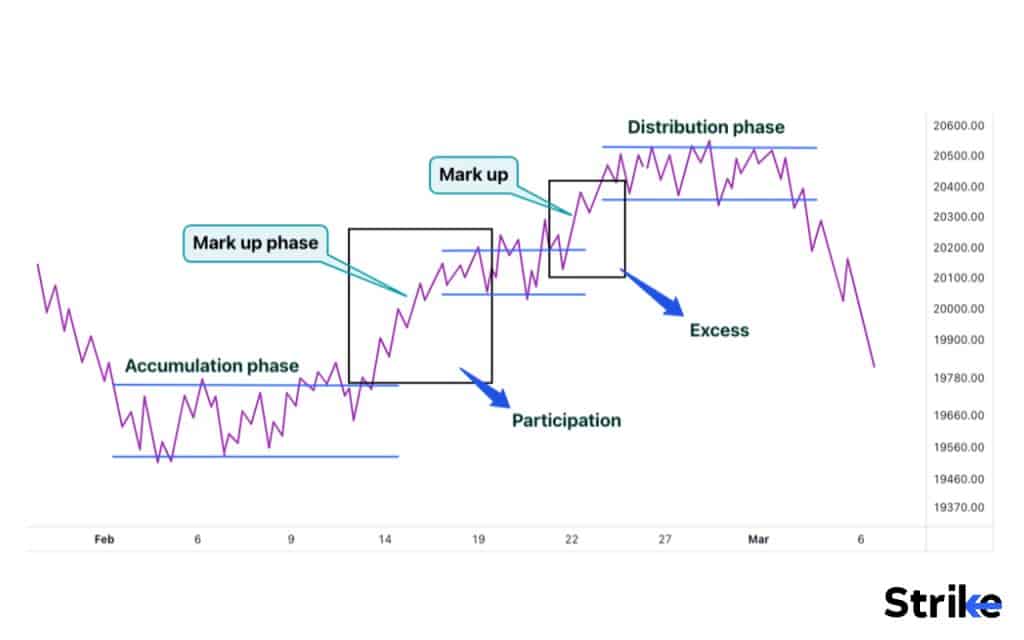
Accumulation happens often when the market is in a bearish sentiment or in a correction. Experienced money investors or institutional investors start buying stocks at attractive prices during this period. These investors are accumulating shares, but the general public is not yet participating.
The Mark up phase is when the broader market (retail participation) is participating in the trend. The trend can be a bull market (rising prices) or a bear market (declining prices). The general public starts buying shares as the market moves up if bullish, and during a bear market, they start selling shares as the market moves down.
The distribution phase sees smart money investors start selling their shares to the public, realising their profits, and taking their money off the table. The public is still buying, and they continue to buy even as the market begins to decline. The market reaches a point where supply exceeds demand, and prices start to fall eventually.
4. The Averages Must Verify One Another
The Dow theory states that indices or market averages must confirm each other for a trend to be considered valid. In other words, it is essential to confirm a trend with other indices or averages to increase the reliability of the analysis if one index or average is showing a particular trend.
In the context of the Nifty 50, one can use the Dow theory principle by considering the confirmation between the Nifty 50 index and the Nifty Bank which is the secondary index most important.
In an uptrend, if the Nifty 50 is in an uptrend; making subsequent Higher Highs and Higher Low’s; investors expect the trend of this index is in correlation with Nifty Bank to also be in an uptrend; confirming the overall trend of the stock market.
5. Volume Supports the Trend
The Dow theory uses volume as an important factor as it is an indication of market strength. The theory suggests that any trend should be confirmed by an increase in trading volume, as it indicates the strength of the trend. It suggests that there is significant participation from buyers or sellers in the market, increasing the likelihood that the trend will continue when the trading volume is high.
For example, let’s say a stock has been trading in a range for several months. Suddenly, there is a surge in buying interest, and the stock starts to trend upward. It suggests that there is strong participation from buyers, and the trend is likely to continue if the increase in buying activity is accompanied by a rise in trading volume. It suggests that the trend may be weak, and the price could reverse if the buying activity is not accompanied by an increase in trading volume.
6. A Trend Continues Until It Issues a Clear Reversal Signal
Dow theory states that a trend continues until a clear reversal signal is issued. A trend is defined as a movement in a stock price that is in one direction for a sustained period of time. Dow theory states that as long as this trend continues without a reversal signal, the trend is assumed to be intact and will likely persist. A reversal signal is any development that suggests that a previously established trend is about to end and reverse direction. This could be a sudden shift in the price of the security, a breakdown in price, or an increase in the volume of trading.
The Dow theory provides a framework for analysing the stock market and identifying trends. It emphasises the importance of understanding the nuances of the market, including the impact of weighted indices, the existence of multiple trends, and the different phases of primary trends.
What is an example of Dow theory in Economics?
An example of Dow theory in Economics is the idea that the stock market discounts all news as soon as it becomes available. This means that investors can analyse the available information and make decisions accordingly.
For example, let’s say that a pharmaceutical company announces that it has successfully completed a clinical trial for a new drug that has the potential to generate significant revenue for the company. The stock price of the company is likely to increase as investors rush to buy shares in anticipation of future profits as soon as the news hits the public.
What are the advantages of Dow theory in economics?
The dow theory has three main advantages including its ability to help monitor market movements. The explanation of these advantages is listed below.
- Ability to Monitor Market Movements: Dow theory helps investors monitor market movements and make decisions based on their observations. For instance, an investor analysing the stock market observes that the Nifty 50 has been on an upward trend for several months. This is accompanied by strong trading volume and price momentum. The investor also notices that the Nifty bank is also rising. This confirms the strength of the market trend. The investor decides to increase their market exposure by investing in individual stocks or exchange-traded funds (ETFs) that track the Nifty 50 or Nifty Bank based on this observation.
- Use of Average Price Movements: Dow theory relies on the concept of average price movements, which is a critical factor in trading decisions. For example, an investor is analysing the stock market and notices that the Nifty 50 has been trending upward for several months. It has consistent price movements above its 50-day moving average. But the investor observes that the Nifty next 50 or Nifty bank Index has also been trending upward, with a similar pattern of consistent price movements above its 50-day moving average. The investor may decide to invest in individual stocks or ETFs that track these indices, anticipating that the trend will continue based on this.
- Ability to Make Informed Decisions: Dow theory allows investors to make informed decisions based on the analysis of market movements. For example, let’s say the Nifty 50 is trending upward, indicating overall market strength, but the Nifty bank or Nifty MidCap is trending downward, indicating potential weakness in the banking or mid cap sector. This could be a signal that the overall market trend may not be sustainable, as the transportation sector is an important indicator of economic health and growth.
The Dow theory can help investors time their entry and exit in the market using the advantages listed. This helps investors potentially make more profit.
What are the disadvantages of Dow theory in economics?
The disadvantages of the Dow theory stem from the fact that it is an old method. Listed below are three main disadvantages of the Dow theory.
- Its lack of price-volume relationship: Dow theory does not account for changes in the trading volume when analysing changes in prices, which could result in incorrect conclusions. For example, let’s say an investor is analysing the Nifty 50 and observes a sustained upward trend in prices over a period of time. But the investor fails to account for changes in trading volume and assumes that the trend will continue indefinitely.
Dow theory accounts for it by explaining that volume should confirm a trend. But its direct negligence of volume in the price chart has proven to be a disadvantage. Basically, big players do not disclose their traded shares; thus the indicator might fail to reflect that information and thus it lacks solid analysis.
- It is said to be outdated: The Dow theory was developed in the early 20th century, and while it has been updated over time, it may not fully reflect the complexities and nuances of the modern stock market. Traders thus had evolved dow theory and have combined it with other technical indicators and liquidity concepts to create a long term winning strategy.
- Dow theory lags behind often: The Dow theory is considered a lagging indicator because it relies on historical price data to identify market trends and predict future price movements. It looks at past price movements to determine the current state of the market and make predictions about its future direction.
- Dow theory may generate false signals during a sideways market: Markets often enter stages of consolidation; wherein bulls and bears are fighting to gain control, during this phase, a trader may lose trades if they are based only on dow theory.
- Dow theory is difficult to learn for newbie traders: Complex dow schematics require a lot of chart time to develop instincts and inner specificities. Dow theory also becomes difficult to realise specific entry or exit points, thus, traders combine dow theory with multiple technical tools to make their entries and exits precise.
What do the critics say about the Dow theory in the Stock Market?
Critics of the Dow theory argue that it does not take into account the fact that stock prices can move sideways, or that the theory does not take into account the impact of fundamental events on the stock market. The theory does not consider the impact of the macroeconomic environment on stock prices, nor does it consider the potential impact of market manipulation by large traders or institutional investors.
How does Dow theory work in Investment?
Dow theory is a market trading strategy that uses technical analysis to identify potential market trends. Dow theory postulates that market trends can be seen in price movements and that it is possible to identify these trends and use them to make profitable investments.The key principles of Dow theory are that the stock market has a primary trend, secondary trends, trend duration, volume and price confirmation, and non-confirmation. Investors can make informed decisions about when to enter and exit the market by studying these trends and movements.
How does Dow theory work in Technical Analysis?
Dow theory is used to identify trends in the market and make trading decisions based on these trends in technical analysis.Technical analysts use a variety of tools and techniques, including charting, trend lines, liquidity concepts and moving averages to help identify and analyse market trends. Technical analysts can make more informed trading decisions and potentially achieve higher returns by understanding and applying the principles of Dow theory.
What is Dow’s theory in Forex?
Dow theory principles can be applied to other financial markets, including the foreign exchange market, also known as Forex.
The basic principles of Dow theory are applied in forex trading to help traders identify trends and potential trade opportunities. The theory involves analysing the price movements of currency pairs and using various technical indicators to confirm the direction of the trend. All dow theory principles are applied in forex trading too. As markets are evolving at a stage where manipulation in scripts is at top; Dow theory is modified and combined with other technical terms known as liquidity concepts, it acts as an edge to take high probability trade setups.
Can one apply the Dow theory to the Stock Market?
Yes, the Dow theory can be applied to the stock market. The Dow theory is used to establish entry and exit points for trading stocks. The Dow theory looks at the behaviour of the stock market index, Nifty 50, and its movements over time to determine the current trend. It takes into account the highs and lows of the index and its overall direction, as well as various other technical analysis indicators like volume, moving averages, and momentum to help determine the trend of the stock market. Dow theory is used by traders and by combining the dow theory with other technical tools, traders manage to take high probability trade setups, taking into consideration the stringent risk management.
What is the difference between Dow theory and Rational Choice theory?
The Dow theory and Rational Choice theory are two different approaches to understanding human behaviour in the stock market.
Dow theory is a form of technical analysis that looks at past market trends to predict future price movements.
Rational Choice theory is a socio-economic approach that assumes people are rational actors who make choices to maximise their benefits and minimise their costs.
Dow theory focuses on market trends and the effects of market psychology, while
Rational Choice theory uses economic incentives to explain human behaviour. Both theories are useful in predicting and understanding markets and human behaviour.









 Previous Article
Previous Article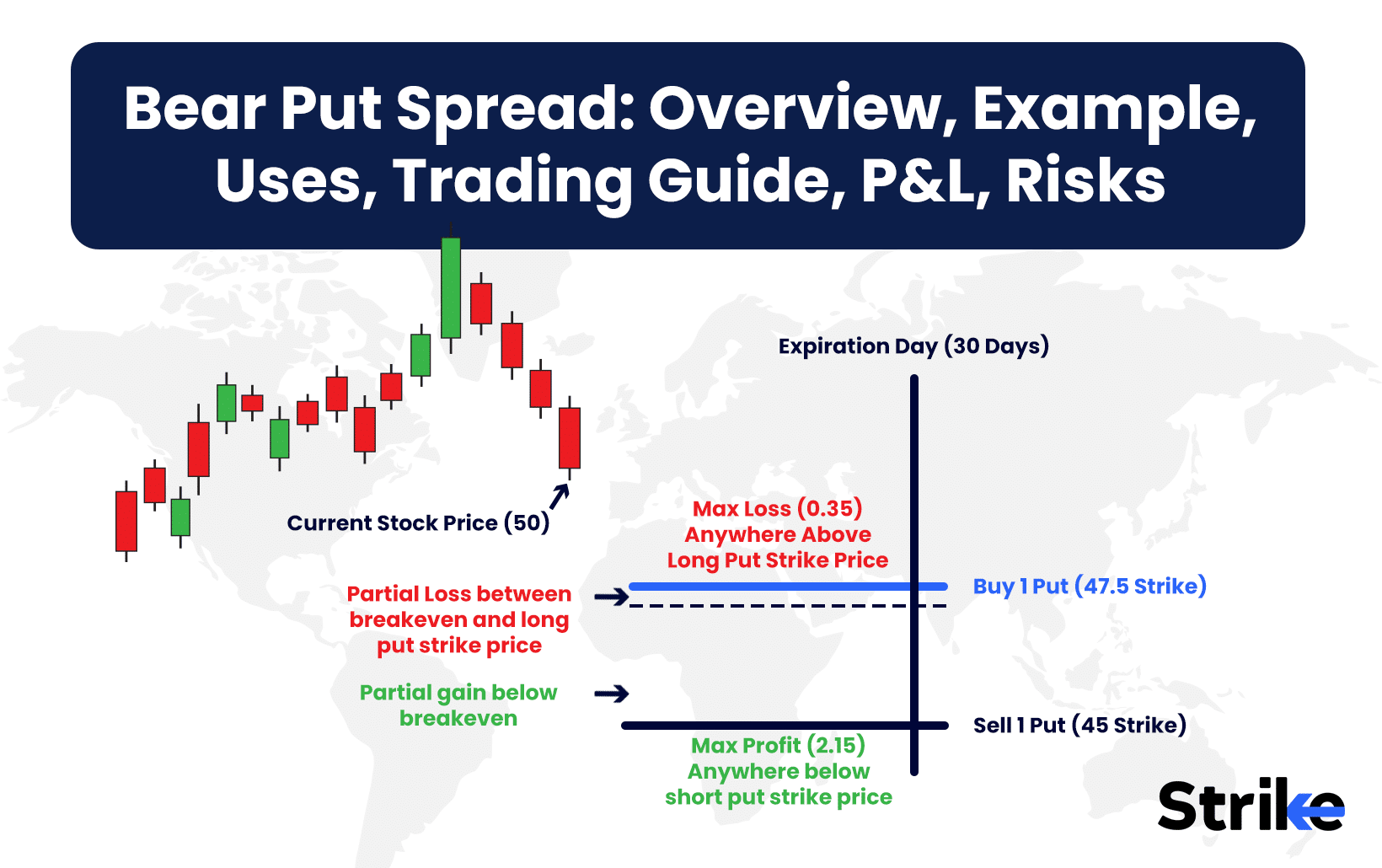
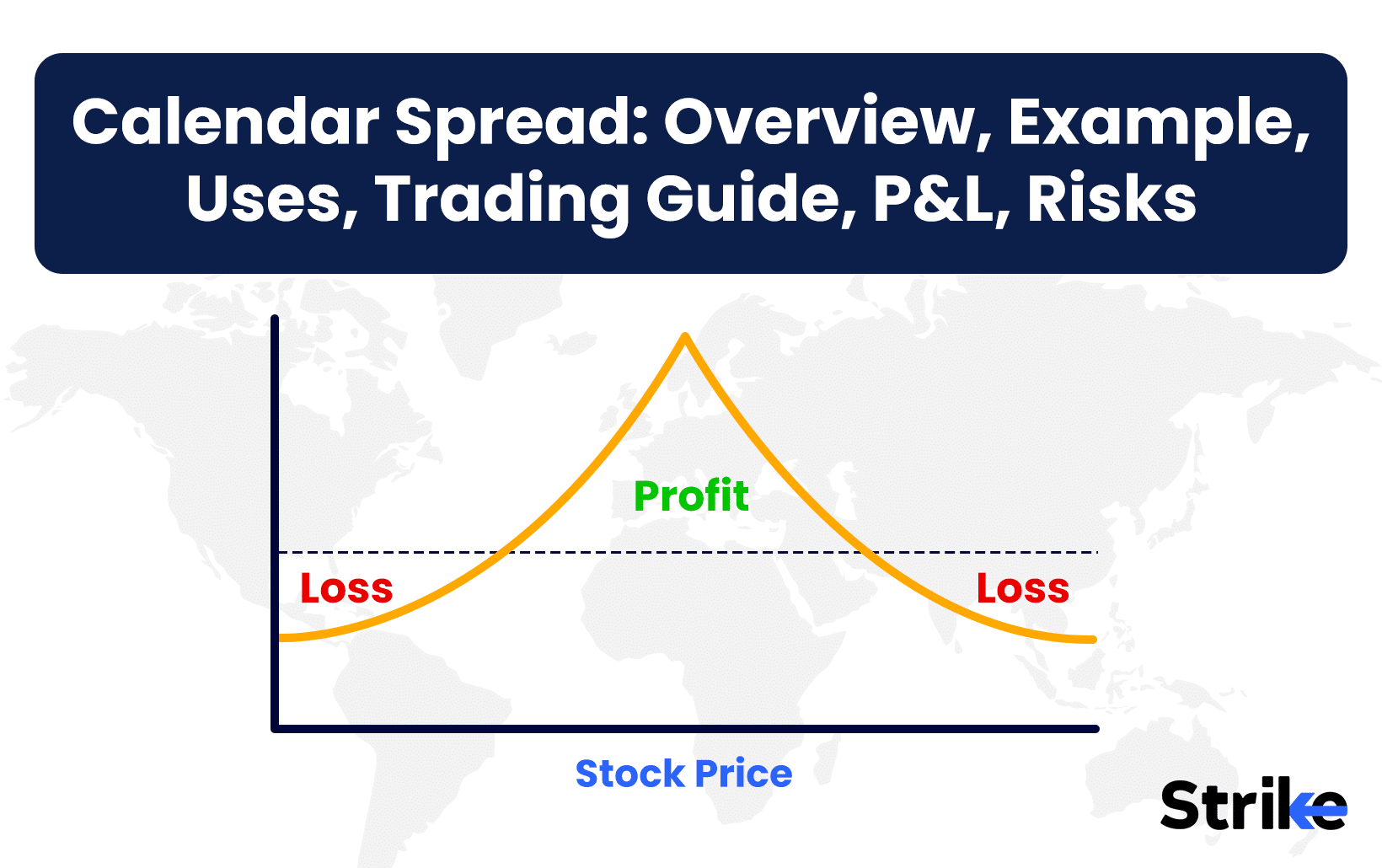
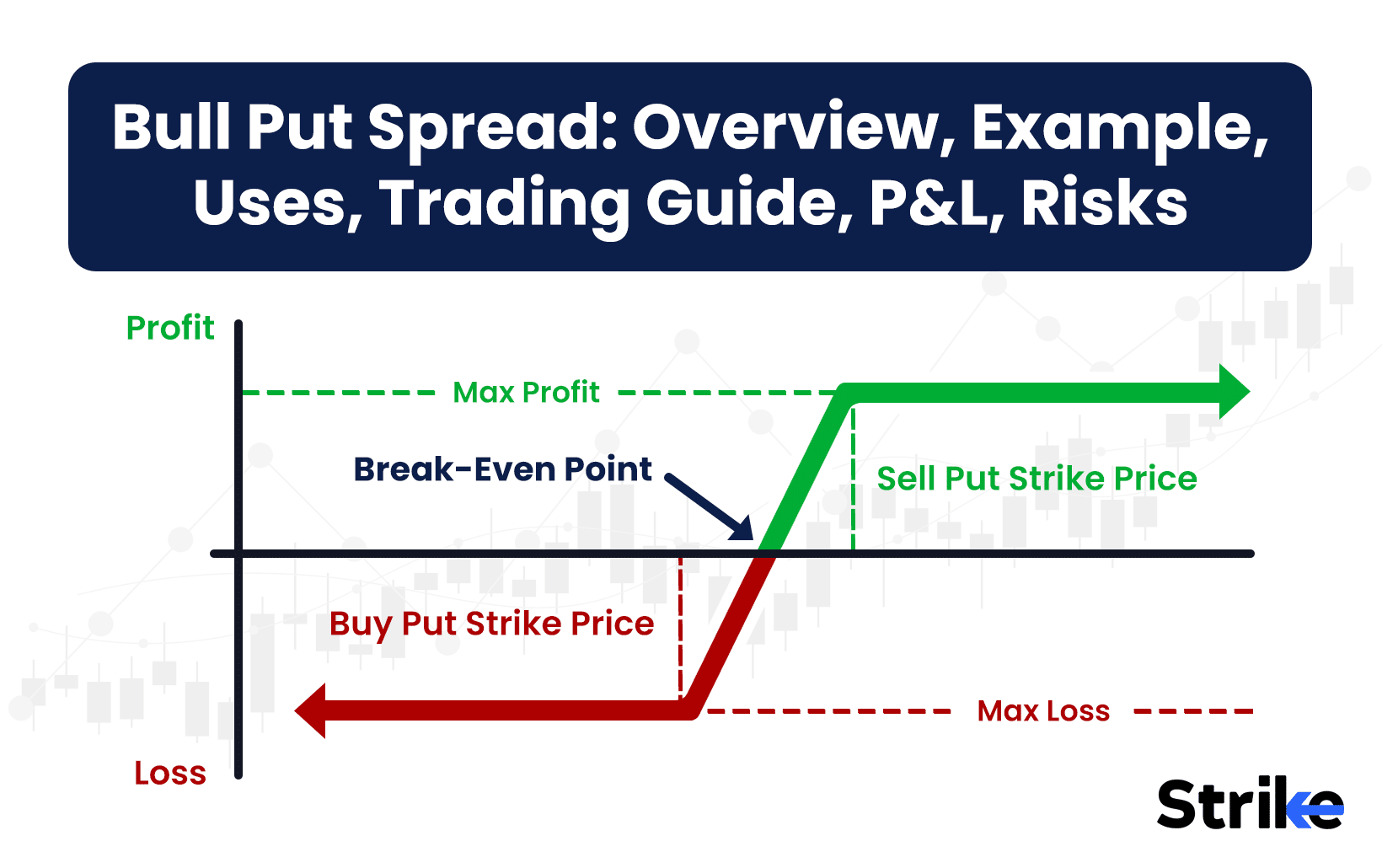




Comments (1)